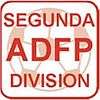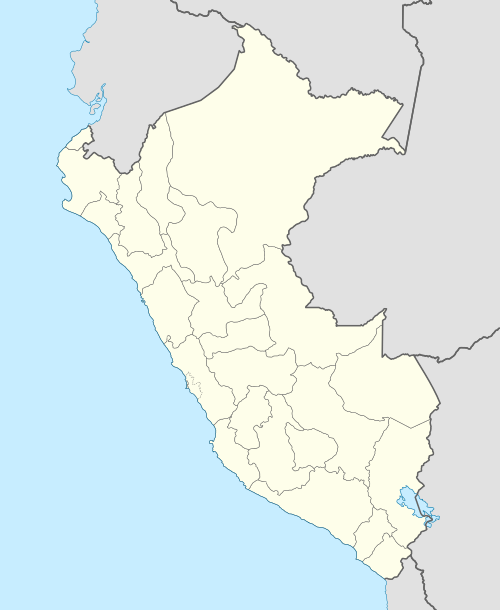Peruvian Segunda División
 | |
| Founded | 1936 |
|---|---|
| Country | Peru |
| Number of teams | 15 |
| Level on pyramid | 2 |
| Promotion to | Primera División |
| Relegation to | Copa Perú |
| Current champions |
Sport Boys (2017) |
| TV partners |
|
| Website | www.adfp-sd.com |
|
| |
The Segunda División Peruana (Second Division) of Peru is the second-highest division in the Peruvian football league system. It is a professional division and was declared a promotional division by the Peruvian Football Federation (FPF). After years of changing numbers of clubs, as of 2017 the league includes 15 clubs. It is currently organized by the Asociación Deportiva de Futbol Profesional - Segunda División.
History
The format of the Second Division has changed over the years. For decades after it was first formed in 1936, only clubs from the Department of Lima participated in the annual tournament. The winner was promoted to the Primera Division Peruana (First Division), the professional league.
- 1988-1990, the winner was promoted to the Regional Metropolitan League (Torneo Metropolitano Regional).
- 1991, there was no promotion because the First Division was undergoing major changes.
- 1992, the format changed again. This time the winner of the tournament would play against the winners of the northern, southern and central regions in order to be promoted.
- 1993-1997, the former system, in which the winner was directly promoted to the first division, was used.
- 1998, the winner of the Second Division played a game against the second-to-last placed club of the First Division, to determine which would be in the First Division.
- 1999-2003, the former system of promotion and relegation was used.
- 2004-2008, a new format was adopted, in which the winner and runner-up of the Second Division would play in the Round of 16 of the Copa Perú.
- 2009, the winner of the tournament was promoted to the First Division, while the last team was relegated from the tournament and played in the 2010 edition of the Copa Perú. Their places were taken by the two relegated clubs of the First Division, and the team that finished in third place in the 2009 Copa Perú.
- 2010, the former system, in which the winner was directly promoted to the first division, was used. Two teams left the tournament before its start which reduced the number of teams participating back to ten.
- 2011, Ten teams played a home and way tournament and split the second half into to groups, the top five teams from the previous stage decided the Champion while the bottom five fought against relegation.
- 2012, the former system, in which the winner was directly promoted to the first division, was used.Two teams left the tournament before its start which reduced the number of teams to ten and automatically relegated them to the 2013 edition of the Copa Peru.
- 2013, the leagues was expanded to 16 teams. A rigorous financial stability check was implemented which only 14 teams passed. Two teams were relegated to the 2014 edition of the Copa Peru.
Competition format and sponsorship
Since 2006, the winner of the tournament is promoted to the First Division, while the last two teams are relegated from the tournament to the Departamental Stage of the Copa Perú. Their places are taken by the two relegated clubs from the First Division, and the team that finishes second place in the Copa Perú.
Sponsorship
The Peruvian Segunda División is sponsored by Best Cable Perú, a local cable company, hence the name Copa Best Cable Perú. They have had exclusive broadcasting rights.
Criticisms
The Segunda División has received numerous criticisms, chiefly due to the lack of stability in the process of competition and promotion, and the lack of professionalism.[1]
Team count
The Segunda División has changed the number of teams that operate in the league several times. Over the course of 74 years, the Segunda has had as few as four teams and as many as 16. The early Segunda División were played with an average number of teams ranging from 4 to 10. Prior to the current 12-club Segunda División, during the 2000s, the team count continued to fluctuate between 10, 12, 14, 16 and even a surprising 13. For example, 12 teams competed in 2009, 10 competed in 2008, 11 competed in 2007, and 12 teams competed from 2004-2006. The over-all goal of the organization is to have a stable league of 16 teams.
Artificial turf
Several stadiums used in the second division have artificial grass installed for the so-called massification of sport.[2] Most stadiums in Peru are owned by the IPD (Instituto Peruano del Deporte), which is the state group responsible for supporting the use of artificial turf. This has been severely criticized by top division teams and the media. At first, these artificial turfs were installed for the 2005 FIFA U-17 World Cup; however, more artificial turf was installed in other stadiums after the U-17 World Cup concluded.[3] These turfs are criticized for having a negative influence on the game and for the injuries which they cause to players.
Clubs
Currently, 16 clubs participate in the Segunda División, a change since the 2012 season because two teams withdrew before the start of the season. Five of the clubs are from Lima, and the remaining clubs make up the five teams from the country's interior. Prior to the current 10-club Segunda División, 12 teams competed in 2009, 10 competed in 2008, 11 competed in 2007 and 12 teams competed 2004-2006. In 2001 and 2002, the Segunda División played with a record 16 teams. In 2011, 12 teams will compete: 8 of last championship, the two relegated teams of Descentralizado and the second and third place of Copa Perú 2010.
Ciclista Lima and Unión Huaral, currently in the Copa Perú promotion tournament, have four titles won over the other clubs in Peru. Municipal, Guardia Republicana, Mariscal Sucre, Unión Callao, Telmo Carbajo and Carlos Concha trail behind with 3 titles. Universidad César Vallejo, Total Clean, Cobresol, and José Gálvez are the only clubs outside the metropolitan area of Lima to have won a Segunda Division championship. In addition, Alianza Lima, Atlético Chalaco, Centro Iqueño, Defensor Lima, Municipal, Mariscal Sucre, San Agustín, Sport Boys, and Unión Huaral are the only teams that have been champions of First and Second Division.
Since the Second Division began at the national level in 2006, only 18 of the 25 regions have had representative teams in the Second Division. These are Ancash, Apurímac, Arequipa, Ayacucho, Cajamarca, Callao, Huánuco, Ica, Junín, La Libertad, Lambayeque, Lima, Loreto, Moquegua, Piura, Puno, and Ucayali.
Stadia and Locations

| Team | City | Stadium[4] | Capacity[5] |
|---|---|---|---|
| Alfredo Salinas | Espinar | Municipal de Espinar | 12,000 |
| Alianza Atlético | Sullana | Melanio Coloma | 5,000 |
| Carlos A. Mannucci | Trujillo | Mansiche | 25,000 |
| Cienciano | Cusco | Garcilaso | 40,000 |
| Cultural Santa Rosa | Andahuaylas | Monumental de Condebamba | 10,000 |
| Deportivo Coopsol | San Vicente de Cañete | Roberto Yáñez | 5,000 |
| Grau | Piura | Miguel Grau | 25,000 |
| Hualgayoc | Hualgayoc | José Gálvez Egusquiza | 2,000 |
| Juan Aurich | Chiclayo | Municipal de la Juventud | 2,000 |
| Los Caimanes | Puerto Etén | Municipal de la Juventud | 2,000 |
| Serrato Pacasmayo | Pacasmayo | Carlos A. Olivares | 2,000 |
| Sport Loreto | Pucallpa | Aliardo Soria | 25,000 |
| Sport Victoria | Ica | José Picasso Peratta | 8,000 |
| Unión Huaral | Huaral | Julio Lores Colan | 10,000 |
| Universidad César Vallejo | Trujillo | Mansiche | 25,000 |
Champions
Peruvian Segunda División had amateur status since its foundation until 1987. In the course of this era, Telmo Carbajo, Ciclista Lima, Unión Callao, Carlos Concha and Mariscal Sucre shared the most titles. The first run from 1936 to 1987 featured clubs only from Lima and Callao. In 1988 the league obtained professional status and in 2006 expanded the league to the entire nation, beginning the Segunda División Nacional.
Titles by club
Titles by region
| Region | Nº of titles | Clubs |
|---|---|---|
| Lima | 46 | Ciclista Lima (4), Unión Huaral (4), Municipal (3), Guardia Republicana (3), Mariscal Sucre (3), Unión Gonzáles Prada (3), Alcides Vigo (2), Defensor Lima (2), Olímpico Aurora (2), Porvenir Miraflores (2), Alianza Lima (1), América Cochahuayco (1), AELU (1), Association Chorrillos (1), Aviación (1), Centro Iqueño (1), Compañía Peruana de Teléfonos (1), Defensor Arica (1), Enrique Lau Chun (1), Juventud La Palma (1), Lawn Tennis (1), Mariscal Castilla (1), Pacífico (1), San Agustín (1), Santiago Barranco (1), Sport Coopsol (1), Internazionale (1), Unión América (1) |
| Callao | 23 | Carlos Concha (3), Telmo Carbajo (3), Unión Callao (3), Sport Boys (3), Hijos de Yurimaguas (2), Jorge Chávez (C) (2), KDT Nacional (2), SIMA (2), Atlético Chalaco (1), ADO (1), Cantolao (1) |
| Ancash | 1 | José Gálvez (1) |
| Arequipa | 1 | Total Clean (1) |
| Cajamarca | 1 | Comerciantes Unidos (1) |
| La Libertad | 1 | Universidad César Vallejo (1) |
| Lambayeque | 1 | Los Caimanes (1) |
| Moquegua | 1 | Cobresol (1) |
See also
References
- ↑ Becker, Wolfy (6 March 2007). "The dreadful situation of Peruvian football". Wolfy Becker. Archived from the original on 31 January 2009. Retrieved 15 June 2009.
- ↑ "Woodman: "No habrá cambio de césped en el Elías Aguirre"" [There will not be changes to the field in the Elías Aguirre] (in Spanish). Peru.com. Retrieved 26 April 2010.
Agregó que de ninguna manera se cambiara el césped sintético a los demás estadios del país que tienen este tipo de gramado. 'Nosotros estamos para masificar el deporte y el pasto sintético es un tema apoyado por la FIFA.... Además sí se puede jugar al fútbol, como se juega en todos lados' subrayó Woodman.
- ↑ "Three Companies re-sign agreement". FIFA. Retrieved 26 May 2010.
Polytan Sportstättenbau GmbH, the German-based company, won the tender for installing 4 fields in Peru, all of which were used for the FIFA U-17 World Championship Peru 2005. This was the first time a FIFA Final tournament was played entirely on artificial turf.
- ↑ Most stadiums are owned by the Instituto Peruano del Deporte (IPD).
- ↑ "Peru". fussballtempel.net. Archived from the original on 25 February 2008. Retrieved 2008-02-02.
External links
- FPF Official Federation Website